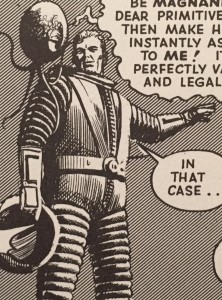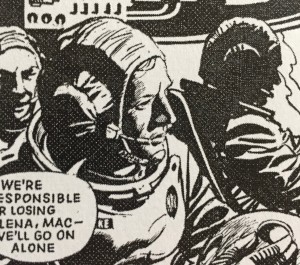8 October 2017
Sydney has always stated that there is no time-line in Jeff Hawke, at least not until after HEIR APPARENT and C-day. He says that he didn’t want to be constrained by having always to ensure that events in one story had to be informed by those that had occurred in previous ones. While a timeline can enrich and give a series continuity and an internal realism , it can also provide constraints. Jeff hawke, as Sydney conceived it , was a series of freestanding stories, with little to tie them together except the main characters.
An advantage that this gave was that ,he could introduce technical innovations when as as he thought fit without reference to earlier stories. An example of this is the evolution of Hawke’s various spacesuits as drawn throughout the series, which represent the spectrum of those depicted in sci-fi during the fifities and sixties and when science finally caught up with science-fiction in the form of the US space programme , Hawke was accordingly attired in a NASA style suit

The earliest spacesuits that we see in the Hawke series are those worn by the Earth

crews who are building the Earth defences against the imminent MARTIAN INVASION. The style is that of a rigid suit with points of articulation at elbows and knees etc, with the ubiquitous bubble helmet so popular among pulp illustrators at the time. The Adventure annual of 1953, for example, has cover art with precisely this type of suit . As the strip reached OPPOSITE POWER , the suit had evolved into the “space armour “ style with fully articulated arms and legs and with a closed-in helmet with visor, a style which Sydney retained through to OVERLORD and beyond, and which became the JH “look” for a number of years. Again, this type of spacesuit was popular among sci-fi artists and was also seen as a realistic possiblity as to how real astronauts might look in the future. A magasine article form 1956 which speculated on what real suits might be like, mocked up such a suit to demonstrate to its readers what we might wear in space. Chesley Bonastall, who illustrated the groundbreaking “ Conquest of space “ (1949) influenced many later sci-fi artists, Sydney included, and depicts several astronauts wearing suits similar to those of the OVERLORD type

As time went on and space exploration became a reality with the “Space race” of the nineteen sixties, the Hawke strip also took on board these more realistic elements and both ships and equipment started to resemble those actually used by NASA . Thus the spacesuits we see in the strip took on a more realistic look and when the crew descend into the crater Plato in MOONSTRUCK they look much more like astronaunts from the Gemini programme.
With the beginning of the seventies , when the US moon missions were in full swing , the strip also reflected these new developments and Hawke and Mac, when investigating the alien probe in the environs of Pluto in HERE BE TYGERS look very much like Apollo astronauts. Skipper prossitt

A fascinating review. The fashion houses and Vogue magazine will no doubt be involved when Virgin Galactic launches its ‘experience of a life time trip’ into stratosphere.